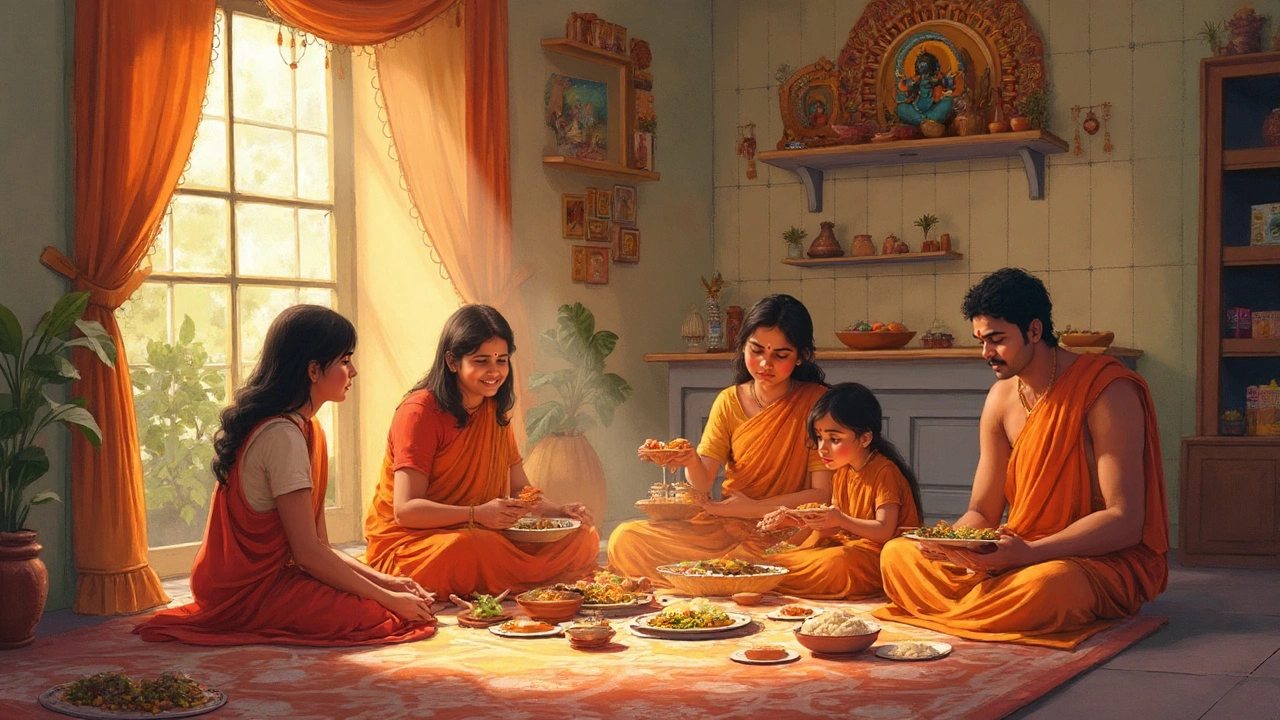Imagine strolling through a busy Indian market filled with the sizzle of street food, the aroma of spices in the air, and every kind of ingredient stacked up high—except for pork. Now, you might wonder: while Hinduism isn’t as strict about meat for some as, say, Islam or Judaism, why is pork so rarely found at a Hindu dinner table? The answer isn’t just about religion—or taste. Food is tangled up with tradition, geography, faith, and even science, all weaving together in fascinating ways that explain why you’ll spot a samosa way before you’ll see a bacon rasher in most Hindu kitchens.
The Roots: Culture, Faith, and Ancient Indian Life
The story starts long before supermarkets and fast food, back in the days when people lived close to forests, rivers, and farms. In ancient India, cows had their holy spot in Hindu beliefs, but pigs never really got that same glow. Temples inscriptions, old texts like the Manusmriti, or the Vedas, rarely mention eating pork. Hinduism—it’s a way of life more than a rulebook—lets families decide for themselves, but the idea of purity sits right at the center.
For Hindus, purity is as everyday as brushing your teeth. Pigs, well, they get a bad rap because of what and where they eat—think garbage dumps and muddy fields. In a place where rivers are holy and simple living is admired, pork just didn’t fit the vibe. In fact, ancient Indian towns were built along clean water sources, and food was supposed to be natural, sattvic, and gentle on the body. This shapes not just what people eat, but how they eat, and even what they cook it in.
If you peek into stories told for generations, pigs rarely star in positive roles. They're seen as impure, and this is echoed at big Hindu festivals and rituals—nobody is passing a platter of pork chops. Instead, you’ll find sweets, fruits, milk, or maybe a vegetarian curry. Temples and sacred events run on vegetarian offerings, and pork isn’t allowed in the kitchen, let alone on a plate. The trend stuck through the eras—kings, peasants, city slickers, or villagers—all generally skipped pork, passing those habits down the line.
The other thing? The Hindu society that popped up around the Indian subcontinent didn't have pigs as a big farm animal. Most Indian states have barely any history of raising pigs for food. Goats, cows, fish, and chickens? Sure. But pigs were more likely scavenging on the edge of town than raised on tidy farms. This wasn’t just about spiritual fears; it was about economy, sanitation, and what was practical to keep alive with the local resources, especially without modern refrigeration.
Hindu scriptures like the Bhagavad Gita, Upanishads, and Puranas don’t drop strict “do not eat pork” edicts. Still, they push vegetarianism as the ideal—for kindness (ahimsa) and mental clarity. The closer someone comes to the spiritual ideals in Hinduism, the simpler and cleaner their food tends to get—and pork, with its reputation for mess and filth, is left out. Even today, *why hindus don't eat pork* is explained in Sunday school as a part of keeping the mind and body clean.
Beliefs, Purity, and What’s ‘Clean’ Food
Walk into most Hindu homes and you’ll see kitchens with rules: shoes off, heads covered (sometimes), and food handled with super clean hands. Hindu food habits tie directly into bigger ideas of purity, a concept that flavors everything from holy rivers to eating etiquette. So much so that a woman in her menstrual cycle sometimes doesn’t cook, and a fallen strand of hair in the cooking pot is a mini-emergency.
To most Hindus, pork falls into the ‘tamasic’ or impure category. This doesn’t mean it’s sinful, just “heavy” and distracting for someone trying to keep a calm, spiritual mind. Pork is fatty, can go rancid quickly in a hot climate, and quotes from old ayurvedic texts describe it as a “slow food”—harder to digest, causing discomfort or even health issues. The Ayurveda, India's ancient wellness science, breaks things down into satvic (pure), rajasic (stimulating), and tamasic (dark, impure). The best foods are satvic—think rice, lentils, vegetables, fruits—and pork doesn’t make the cut.
Ever wondered why guests in a Hindu home often get vegetarian food, even if the family eats meat on their own? That rule goes back to purity, especially when you consider temple events, weddings, or spiritual festivals. Even in modern times, restaurants in India split menus: vegetarian and non-vegetarian—but even non-veg sections rarely have pork. Not because of law, but habit and comfort.
Some rural communities do eat pork—especially tribal groups or those in regions like Nagaland, Mizoram or the North East of India. Their traditions and cuisines don’t follow all mainstream Hindu beliefs. But outside these areas, pork carries stigma, especially in big cities, and among families following mainstream Hinduism. For many, just the idea of eating an animal known for scavenging garbage bins is off-putting. Besides, the association of pigs with filth and pollution means pork is left for those outside the mainstream fold.
Here’s a quick data snapshot you probably didn’t expect:
| Meat Type | Percentage of Indian Households Consuming |
|---|---|
| Chicken | 45% |
| Mutton/Goat | 29% |
| Fish | 26% |
| Pork | 2.5% |
Crazy, right? Out of 1.4 billion people, only a wafer-thin slice regularly eats pork, and the numbers are even lower among Hindu families.
One more thing driving this: street food and family restaurants cater to what people want, and if pork doesn’t sell, it simply isn’t on the menu. This creates a feedback loop—no supply, less curiosity, and even less demand. Hindu festivals—big or small—are largely about purity and simplicity, so pork never makes it into the ritual meal or the after-party. It’s all about keeping “shuddhata”—the Sanskrit word for pure or clean—front and center.

Science, Health, and Modern Hygiene Concerns
Historically, there’s also a practical angle often ignored in polite conversation. Pork is tough to keep fresh without refrigeration, something most people in India didn’t have until quite recently, and many rural areas still lack. A hot climate, unreliable ice, and the danger of diseases like tapeworm, trichinosis, or swine flu made pork riskier than chicken, fish, or mutton—even if you were willing to break from tradition.
There’s a popular saying among grandmothers: “Why bother with pork when you have so many fresh options?” India is bursting with vegetarian and light-meat dishes, so pork just isn’t needed to keep the cuisine interesting. Dishes like dal tadka, paneer curry, or tandoori chicken fill up plates and bellies—no one’s missing out. Plus, the cost of raising pigs for food is higher than for other animals, making pork more expensive and harder to find, especially in the heartland where Hinduism is strongest.
Modern science actually supports some of these old beliefs, at least in part. The pig’s biology means its meat can spoil quickly and, if not handled right, dangerous bacteria or worms could sneak in. This isn’t as big a threat today with cold chains and food safety rules, but that old wisdom sticks around. In places where sanitation is still an issue, pork continues to be a risky bet for many families, especially those who’ve never eaten it and don’t know how to prep or cook it safely.
Doctors sometimes advise high-risk groups—kids, pregnant women, elderly—to skip pork, just in case. Sure, you can find perfectly safe, delicious pork in upmarket restaurants or in states where pork traditions run deep, but the average Hindu household just doesn’t consider it worth the trouble. Many families pass down warnings—“pigs eat filth, so pork is filthy”—and those ideas get woven into everyday decision-making, even if they outlast their original reasons.
For vegetarians and meat-eaters alike in the Hindu community, there’s often pride in sticking with local, time-tested foods. For example, a Hindu friend might tell you he’s never tried a bacon sandwich, and doesn’t feel like he’s missing out. Instead, the family has their cherished recipes—paneer bhurji, chana masala, chicken curry—that keep everyone full and happy, no pork required.
What Happens Today: Regional Differences and Changing Attitudes
Here’s where the story gets really interesting. The rules about pork aren’t carved in stone—there are surprising exceptions all over the map. In states with lots of tribal communities (think Nagaland, Mizoram, parts of Jharkhand or Chhattisgarh), pork is popular and even considered a delicacy. These regions have different histories and traditions, often separated from mainstream Hindu influence due to geography or colonial history. Here, pork will feature in festival meals and even community feasts. And the food is delicious!
Among the big majority of Hindus, though, pork is still out of bounds. Even when families travel or move abroad, you’ll notice that the Indian sections of supermarkets rarely stock pork, and Indian grocery stores might not carry bacon or ham at all. Instead, there’s a wall of ghee, dal, and spices—just like home. This isn’t due to official religious rules, but social comfort and inherited habits. Kids grow up eating the family favorites, and pork simply never enters the kitchen.
India’s younger generation, chatting on social media or watching international food shows, sometimes gets curious. You’ll find the rare adventure-seeker sampling pork in Goa or ordering a pulled-pork burger in Mumbai. But by and large, old beliefs linger—even among those who’ll munch on a chicken burger or dig into a fish curry. The belief that pork is ‘unclean’ or simply not needed is strong enough to keep it mostly off the table.
Outside India, the story can shift. In places like the U.S., U.K., or Australia, Hindu families sometimes try new dishes, especially second-generation kids. But even then, the pork question is a big one. Peer and family pressure, combined with a general lack of craving for pork, usually wins out. Plus, there’s always the question—is it worth breaking tradition for one meal, when there are so many other foods out there?
Food habits connect deeply to identity. To many Hindus, sticking with familiar, safe, and ‘pure’ food is a way to keep the cultural thread unbroken no matter where in the world they find themselves. If deep-fried snacks, creamy paneer, fragrant biryanis, and smokey tandoori hits the spot, why reach for something your ancestors always avoided?
At the same time, food scenes in some Indian cities are changing. Restaurants in upmarket neighborhoods sometimes feature pork, mainly as a ‘foreign’ or Western cuisine item—but rarely in traditional Indian fare. Even those who eat it sometimes keep quiet for fear of upsetting parents or extended family. The stigma is strong, and habits fade only slowly.
So, to sum up in a chatty nutshell: the reason Hindus don’t eat pork has layers—ritual purity, old stories, social stigma, health, practicality, and more than a little grandma-wisdom. Pork may be off the menu for most, but Indian cuisine is so rich, nobody’s going hungry. And if you ever get invited to a Hindu home for dinner, don’t ask for bacon—you’ll thank me later!
